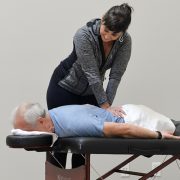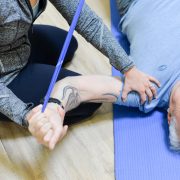Your Pains Location May Not be it’s Source
Pain is both a confusing and scary topic.
There’s lots of advice out there on what to do when you experience pain and it’s hard to know who to listen to. Should you rest – exercise – apply heat – apply ice – see a doctor – get an MRI – or just wait it out to see if it goes away on its own? Any or all of this advice could be right – but it’s irrelevant until you accurately determine where your pain is coming from.
For example, if you have pain in your knee, and it’s coming from your back, the best knee treatment in the world isn’t going to fix it. Inaccurate diagnosis of pain is one of the most common reasons why so many people suffer longer than they need to, and it’s one of the biggest contributors to unnecessary procedures and surgery. You must accurately determine the source of your pain for treatment to be effective. And the location of your pain, alone, is not a reliable way to figure that out.
Let me explain.
I’ve met people who’ve suffered from unrelenting tennis elbow for years – despite treatment protocol after treatment protocol – only to find out it was coming from their neck. I’ve met people who’ve undergone major knee surgery and it failed – only to find out later they never actually had a knee problem. Isolated extremity pain (knees, elbows, shoulders) is one of the most mis-diagnosed problems in the musculoskeletal world. In a study published in the Journal of Manipulative Therapy, they found that over 40% of people suffering from isolated extremity pain had a spinal source responsible for their symptoms, even when there wasn’t any spine pain. In other words, the pain they were feeling in their knee, elbow, or shoulder was actually coming from their back or neck (respectively).
Confused? I don’t blame you.
But more importantly, how do you reliably figure out the source of your pain when it’s not always where you’re feeling it?
As already mentioned, the most common place for this to happen is with extremities. If you’ve got shoulder, elbow, or knee pain, and you don’t recall having a specific injury to it, you must consider that it could be coming from your spine. There’s a 40% chance that it is. Where this gets really confusing is that typically, when you’ve got isolated knee or shoulder pain that won’t go away, your doctor will order an MRI. And if you’re over 40 years old, the MRI will almost always show “something”. It could be a torn rotator cuff, torn meniscus, arthritis, or wear and tear. But what most people don’t realize is that these findings are quite normal and happen naturally as you age.
Just because they show up in your MRI – doesn’t mean they are responsible for your pain. Despite the science proving this over and over – doctors continue to order these tests and rely on them to make important decisions about treatment. It’s how people end up undergoing unnecessary procedures or surgery – they let images and an inaccurate diagnosis lead the way.
Whenever I meet someone with isolated extremity pain, especially if it came on suddenly and out of nowhere, I always consider that it could be coming from their spine.
How can you figure this out?
Well, it’s challenging to figure it out on your own. But if you work with a movement specialist who understands this concept – you’ll be able to figure this out accurately. The basic premise is that if you can move your spine in specific directions – repeatedly – and influence the symptoms you feel in your extremity – then there is a very good chance your problem is coming from your spine. Or at the very least, your spine is involved. And whenever your spine is responsible solely or partially for pain elsewhere – and it’s ignored – your problem will persist and likely get worse over time if it’s not addressed.
Moral of this story… If you’ve had pain in one of your extremities for a while now, and it’s not going away, it’s possible you’ve missed the source, and that where your pain is may not be where your problem is. And if you’re considering some kind of surgery or procedure, you definitely want to rule out that the problem could be elsewhere.
Specialized movement exams are one of the most reliable ways to figure this out – studies have proven it. If you’ve had unexplained pain in your elbow, knee or shoulder that isn’t going away, look for someone who understands this and can give you a proper movement exam to accurately identify the source of your pain.
Looking for help and local to Portsmouth, NH? Click here to speak with a specialist.
Dr. Carrie Jose, Physical Therapist and Pilates expert, owns CJ Physical Therapy & Pilates in Portsmouth and writes for Seacoast Media Group. To get in touch, or get one of her free guides to knee and back pain, visit www.cjphysicaltherapy.com or email [email protected].










